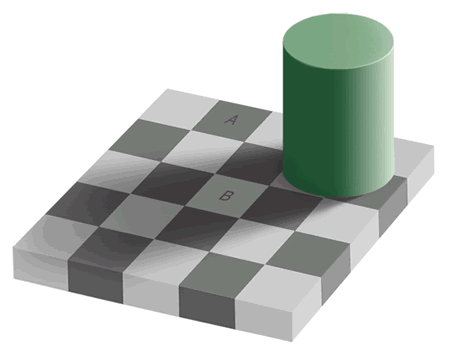Skip over navigation
Have a look at this picture of a chessboard. There is a cylinder placed on the board which is casting a shadow:

Look at the squares marked A and B.
Do you think they are the same colour or different colours?
Show this image to some other people. Perhaps you could ask other children in your class, or members of your family.
What do they think? Are the squares the same colour or different colours?
Keep a record of how many people think they are the same and how many think they're different.
When you've asked, say, 10 people (you might be able to ask more), have a look at your results.
What percentage of people you asked thought they were the same?
What percentage thought they were different?
Now, have a look at this picture . (It will open in a new window.)
This new image shows the same chessboard and cylinder, but now the squares A and B are joined by two strips which are the same colour at all points.
What do you think now? Are squares A and B the same colour as each other or not?
Show this new picture to the same people you showed the first one to.
What do they think? Are the two squares the same colour or different colours?
Do any of them change their mind compared with their first answer?
What percentage think they are the same now?
If you look at this second set of data you've collected, does it persuade you to change your mind?
How could you convince yourself and others that the squares are the same colour or not?



Or search by topic
Number and algebra
Geometry and measure
Probability and statistics
Working mathematically
Advanced mathematics
For younger learners
Compare the Squares
Age 7 to 11
Challenge Level 





Have a look at this picture of a chessboard. There is a cylinder placed on the board which is casting a shadow:

Look at the squares marked A and B.
Do you think they are the same colour or different colours?
Show this image to some other people. Perhaps you could ask other children in your class, or members of your family.
What do they think? Are the squares the same colour or different colours?
Keep a record of how many people think they are the same and how many think they're different.
When you've asked, say, 10 people (you might be able to ask more), have a look at your results.
What percentage of people you asked thought they were the same?
What percentage thought they were different?
Now, have a look at this picture . (It will open in a new window.)
This new image shows the same chessboard and cylinder, but now the squares A and B are joined by two strips which are the same colour at all points.
What do you think now? Are squares A and B the same colour as each other or not?
Show this new picture to the same people you showed the first one to.
What do they think? Are the two squares the same colour or different colours?
Do any of them change their mind compared with their first answer?
What percentage think they are the same now?
If you look at this second set of data you've collected, does it persuade you to change your mind?
How could you convince yourself and others that the squares are the same colour or not?
You may also like
Florence Nightingale - the Compassionate Mathematician
Florence Nightingale may be well known for her role as a nurse, but she was also an excellent mathematician, collecting and analysing data to help improve hospital conditions.
Real Statistics
Have a look at this table of how children travel to school. How does it compare with children in your class?
Birds in the Garden
This activity asks you to collect information about the birds you see in the garden. Are there patterns in the data or do the birds seem to visit randomly?

